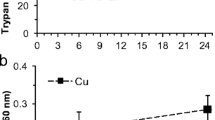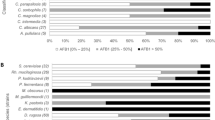Summary
Four methods were used to screen nine organotin and two organolead compounds for toxicity to 29 yeasts, representing 10 genera. Center well diffusion plates were useful in comparing the sensitivity of yeasts to the most toxic organometals but were not useful for comparisons between compounds because of differences in diffusion rates and lack of sensitivity. Two-layer diffusion plates (density gradient plates) were also of limited use for comparisons between compounds but provided quantitative information on toxicity and allowed comparisons between organisms. Two-dimensional diffusion plates were useful for estimating the effect of pH on organometal toxicity. Release of K+ from cell suspensions measured using a K+-electrode provided quantitative information and allowed comparisons between compounds and organisms. The presence of 3% NaCl in cell suspensions decreased the rates and extent of organotin-induced K+ release. Yeasts varied in their sensitivity from strain to strain, but tributyltin was the most toxic compound tested. Mono- and dimethyltins were the least toxic. Triphenyltin, dibutyltin, monobutyltin, trimethyltin, triethyltin, diethyllead, diethyltin, and dimethylleads showed intermediate toxicity, but triphenyltin and monobutyltin were the most toxic among the group.
Similar content being viewed by others
References
Blunden, S.J. and A.H. Chapman. 1986. Organotin compounds in the environment, In: Organometallic compounds in the environment—principles and reactions, (P.J. Craig ed.), pp. 111–159, Longman Group, Bath Press, Avon, U.K.
Borst-Pauwels, G.W.F.H. 1981. Ion transport in yeast. Biochim. Biophys. Acta 650: 88–127.
Borst-Pauwels, G.W.F.H. 1988. Simulation of all-or-none K+ efflux from yeast provoked by xenobiotics. Biochim. Biophys. Acta 937: 88–93.
Brinckman, F.E., J.A. Jackson, W.R. Blair, G.J. Olson and W.P. Iverson. 1983. Ultratrace speciation and biogenesis of methyltin transport species in estuarine waters. pp. 39–72, In: (C.S. Wong, E. Boyle, K.W. Bruland, J.D. Burton and E.D. Goldberg eds.), Trace metals in sea water (NATO Conf. Ser. 4: 9), Plenum Press, New York.
Champ, M.A. and F.L. Lowenstein. 1987. TBT: The dilemma of high-technology antifouling paints. Oceanus 30: 69–77.
Chau, Y.K., P.T.S. Wong, O. Kramar and G.A. Bengert. 1981. Methylation of tin in the aquatic environment, pp. 641–644, In: Proc. 3rd Int. Conf. Heavy Metals in the Environment, Amsterdam, The Netherlands, CEP Consultants Ltd., Edinburgh.
Cooney, J.J. 1988. Microbial transformations of tin and tin compounds. J. Ind. Microbiol. 3: 195–204.
Cooney, J.J. 1988. Interactions between microorganisms and tin compounds, pp. 92–104 In: (P.J. Craig and F. Glockling eds.), The biological alkylation of heavy elements, Royal Societty of Chemistry, London.
Cooney, J.J., L.E. Hallas and J.C. Means. 1981. Tin and microbes in the Chesapeake Bay, U.S.A., pp. 243–245. In: Proc. 3rd Int. Conf. Heavy Metals in the Environment Amsterdam, The Netherlands, CEP Consultants, Ltd., Edinburgh.
Cooney, J.J., and G.W. Pettibone 1986. Metals and microbes in toxicity testing. Toxicity Assessment: An International Quarterly 1: 487–499.
Gadd, G.M. 1986. Toxicity screening using fungi and yeasts, pp. 43–77, In: (B.J. Dutka and G. Bitton eds.), Microbial toxicity testing, vol. 2, CRC Press, Boca Raton, Florida.
Gadd, G.M. and A.J. Griffiths. 1978. Microorganisms and heavy metal toxicity. Microbial Ecol. 4: 303–317.
Gadd, G.M., J.L. Mowll, C. White and P.J. Newby. 1986. Methods for assessment of heavy metal toxicity towards fungi and yeasts. Toxicity Assessment: An International Quarterly 1: 169–185.
Guard, H.E., A.B. Cobet and W.M. Coleman III. 1981. Methylation of trimethyltin compounds by estuarine sediments. Science 213: 770–771.
Gilmore, C.C., J.H. Tuttle and J.C. Means. 1985. Tin methylation in sulfide bearing sediments, pp. 239–258, In: (A.C. Sigleo and A. Hattori ed.), Marine Estuarine Geochem., Lewis Publishers, Inc., Chelsea, MI.
Hallas, L.E. and J.J. Cooney. 1981. Tin and tin-resistant microorganisms in Chesapeake Bay. Appl. Environ. Microbiol. 41: 466–471.
Hallas, L.E. and J.J. Cooney. 1981. Effects of stannic chloride and organotin compounds on estuarine microorganisms. Dev. Ind. Microbiol. 22: 529–535.
Hallas, L.E., J.C. Means and J.J. Cooney. 1982. Methylation of tin by estuarine microorganisms. Sciences 215: 1505–1507.
Hallas, L.E., J.S. Thayer and J.J. Cooney 1982. Factors affecting the toxic effect of tin on estuarine microorganisms. Appl. Environ. Microbiol. 44: 193–197.
Kaars Sijpesteijn, A., F. Rijkens, J.G.A. Luijten and L.C. Willemsens. 1962. On the antifungal and antibacterial activity of some trisubstituted organogermanium, organotin and organolead compounds. Antonie van Leeuwenhoek J. Microbiol. Serol. 28: 346–356.
Mowll, J.L. and G.M. Gadd 1985. The effect of vehicular lead pollution on phylloplane mycoflora. Trans. Br. Mycol. Soc. 84: 685–689.
Newby, P.J. and G.M. Gadd. 1986. Diffusion assays for determination of the effects of pH on the toxicity of heavy metal compounds towards filamentous fungi. Environ. Techn. Lett. 7: 391–396.
Pettibone, G.W. and J.J. Cooney. 1986. Effect of organotins on fecal pollution indicator organisms. Appl. Environ Microbiol. 52: 562–566.
Pettibone, G.W. and J.J. Cooney. 1988. Toxicity of methyltins to microbial populations in estuarine sediments. J. Ind. Microbiol. 2: 373–378.
Szybalski, W. and V. Bryson. 1952. Genetic studies on microbial cross resistance toxic agents. I. Cross resistance ofEscherichia coli to fifteen antibiotics. J. Bacteriol. 64: 489–499.
Theuvenet, A.P.R., B.G.F. Kessels, W.M. Blankensteijn and G.W.F.H. Borst-Pauwels. 1987. A comparative study of K+-loss from a cadmium-sensitive and a cadmium-resistant strain ofSaccharomyces cerevisiae. FEMS Microbiol. Lett. 43: 147–153.
Thompson, J.A.J, M.G. Sheffer, R.C. Pierce, Y.K. Chau, J.J. Cooney, W.R. Cullen and R.J. Maguire. Organotin Compounds in the Aquatic Environment: Scientific Criteria for Assessing Their Effects on Environmental Quality. 283 pp. NRCC No. 229494. National Research Council Canada, Ottawa.
Watanabe, Y. and M. Takakuwa. 1987. Change of lipid composition ofZygosaccharomyces rouxii after transfer to high sodium chloride culture medium. J. Ferment. Technol. 65: 365–369.
Wimpenny, J.W.T. 1981. Spatial order in microbial ecosystems. Biol. Rev. 56: 295–342.
Yamada, J., K. Tatsuguchi and T. Watanabe. 1978. Uptake of tripropyltin chloride byEscherichia coli. Agric. Biol. Chem. 42: 1867–1870.
Zuckerman, J.J., R.P. Reisdorf, H.V. Ellis III and R.R. Wilkinson. 1978. Organotins in biology and the environment. In: (F.E. Brinckman and J.M. Bellama eds.), Organometals and organometalloids. Occurrence and fate in the environment, Am. Chem. Soc. Symp. Ser. 82: 388–424.
Author information
Authors and Affiliations
Rights and permissions
About this article
Cite this article
Cooney, J.J., de Rome, L., Laurence, O. et al. Effects of organotin and organolead compounds on yeasts. Journal of Industrial Microbiology 4, 279–288 (1989). https://doi.org/10.1007/BF01577351
Received:
Accepted:
Issue Date:
DOI: https://doi.org/10.1007/BF01577351




